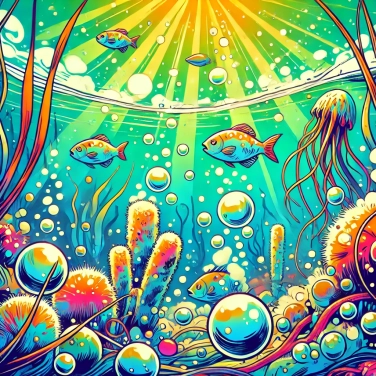Some algae produce toxins to protect themselves from predators, but these toxins can be dangerous for marine mammals when they accumulate in the food chain.

Producing toxins, for an alga, is primarily a matter of survival and competition. By manufacturing these toxic molecules, certain algae deter predators like small crustaceans and fish from nibbling on them. They thus protect themselves effectively, but also gain an advantage over non-toxic algae by reducing competition for space or nutrients. It is a true chemical defense strategy that algae have perfected over the course of evolution to ensure their own success. Some of these toxins also help them inhibit the development of other microorganisms that could compete with them, allowing them to dominate their small marine areas peacefully.
In some species of algae, toxin production primarily comes from their secondary metabolism. In simple terms, these are chemical substances that they produce but do not directly use for growth or respiration. These compounds, known as marine biotoxins, act as a kind of defensive weapon against predators that would want to eat them or against competing species that are vying for resources in their environment. For example, certain microscopic algae called dinoflagellates produce toxins that accumulate in shellfish and fish consumed by marine mammals. The problem is that these toxins directly attack the nervous system once ingested. The algal cells possess specific genes that encode the recipe for making these poisonous molecules, and their production varies depending on environmental stressors. That is why certain situations trigger their toxicity while at other times they remain completely harmless.
When the water warms up a bit too much or certain nutrients like nitrogen and phosphorus reach the ocean in excessive quantities, algae can enter a rapid growth mode. This phenomenon is called algal bloom. As a result, these algae sometimes produce much more toxins. Water that is slightly more acidic or polluted can also worsen the situation by stressing these algae, pushing them to produce even more toxic substances as a defense. Certain times of the year with more sunlight and less water mixing also favor these proliferations. Consequently, weather, pollution, climate change—all of these play a rather concerning role in the multiplication of toxic algae.
The toxins produced by certain algae can seriously affect the health of marine mammals, such as dolphins, seals, and whales. These substances primarily attack their nervous system, causing loss of balance, muscular disorders, or even convulsions. When these mammals swallow contaminated prey, the toxins rapidly accumulate in their bodies. This often leads to severe respiratory difficulties, violent digestive disorders, or even death in severe cases. Even in small quantities, these algal toxins can also disrupt their ability to reproduce or find food, threatening the survival of entire populations.
Some algal toxins, such as saxitoxin, are among the most toxic natural substances known, far surpassing certain toxins produced by terrestrial venomous animals like snakes or spiders.
The algae responsible for red tides, a phenomenon often visible as vast colored patches, can reach toxic concentrations capable of affecting even large marine mammals such as whales.
Although invisible to the naked eye, certain types of toxic algae can quickly contaminate the entire marine food chain and reach marine mammals through bioaccumulation.
The consumption of fish or shellfish contaminated with algal toxins can pose risks to both humans and marine mammals, causing serious neurological disorders, such as respiratory paralysis.
Currently, the direct adaptation of marine mammals to these toxins remains poorly documented and controversial. Although some animals may gradually develop a certain tolerance, these substances remain largely toxic even at low concentrations, often leading to severe, and even fatal, consequences for certain marine populations.
No, only certain specific species produce dangerous toxins. These species, mainly belonging to the groups of dinoflagellates, cyanobacteria, and diatoms, are capable, under certain environmental conditions, of synthesizing toxic substances harmful to marine mammals and other organisms.
Yes, certain algal toxins can also pose a threat to human health. For example, consuming fish or shellfish contaminated with algal toxins can cause severe symptoms such as neurological or gastrointestinal disorders, and in some cases, even death.
The proliferation of toxic algae, often referred to as 'red tide' or 'toxic bloom,' can be identified by its unusual water color, its characteristic foam, or by an increased mortality rate of fish and other marine organisms. Laboratory tests and regular monitoring of coastal waters are used to confirm the presence of specific toxins.
Although it is difficult to control large-scale algal blooms, some preventive measures are feasible, such as reducing agricultural and industrial discharges containing nutrients like nitrogen and phosphorus into coastal waters. Wastewater management and increased monitoring of marine waters can also help mitigate these phenomena.

No one has answered this quiz yet, be the first!' :-)
Question 1/5